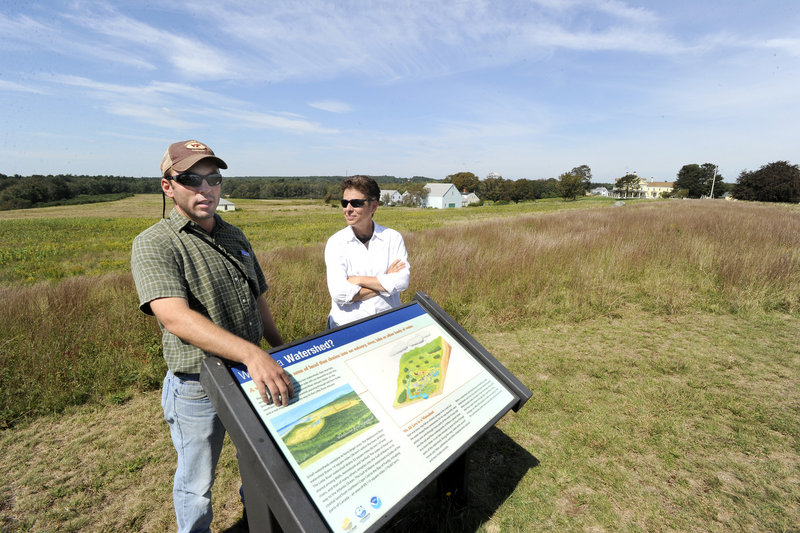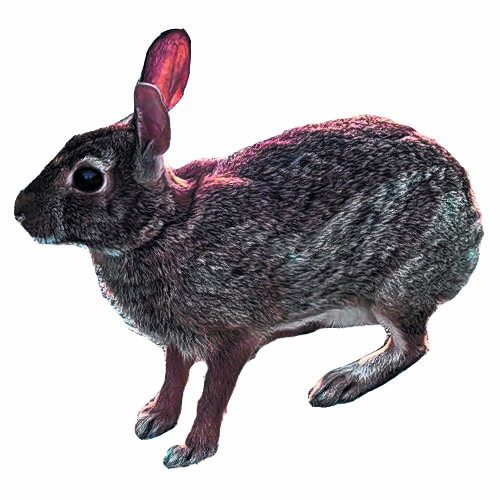WELLS – In late summer the meadows of Wells National Estuarine Research Reserve look like a wild and natural landscape of grasses, wildflowers and shrubs.
But the pastoral scene is actually carefully managed with one special resident species in mind: the New England cottontail rabbit. The reserve is home to one of the few remaining populations of the small, elusive creatures. It’s the only rabbit species native to New England and New York — and keeping it healthy is turning out to be an expensive proposition.
Last summer, the Portland International Jetport had to pay $1 million in mitigation costs for taking rabbit habitat in a runway expansion project.
Now a team of government and private nonprofit agencies is making a major push — funded in part with about $400,000 in mostly public money — to get private landowners to reclaim disappearing habitat, the major threat to the rabbit.
After a decade of managing the landscape, the reserve in Wells has become a model for creating and preserving New England cottontail rabbit habitat.
In August, the U.S. Department of Agriculture Natural Resources Conservation Service hired a wildlife biologist with a $150,000 grant to oversee habitat preservation efforts, including a program to enroll private landowners and reimburse them for the costs of saving or creating habitat.
That program will give out about $250,000 to pay for costs of creating the dense undergrowth of alders, fox grapes and viburnum preferred by the New England cottontail.
“It is labor- and resource-intensive,” said Sue Bickford, natural resources specialist at the reserve.
Armed with a previous $81,000 grant and many volunteers, the reserve also has taken a number of steps to create perfect conditions for the rabbits. Trees used by hawks and other predator birds were removed from the rims of the meadows. Tree-size alders were mowed down with a special harvester to encourage the growth of sprouts — alder bark is a major source of food for the rabbit — and a dense thicket.
When nonnative barberry, honeysuckle and bittersweet took over the mowed area, the reserve had to resort to hand weeding and even herbicides to beat out the invasives.
Two years ago the reserve planted 700 native bushes. Thick brush piles were installed at various spots. The alder trees must be mowed down about every decade or so to prevent the area from returning to forest.
So far, said Bickford, the management efforts appear to have worked. Even though in 10 years at the reserve, Bickford has yet to see any of the rabbits, the latest studies show the resident population is thriving. Today there are 20 rabbits, considered a large colony.
No one knows exactly how many New England cottontails remain. It appears they have been totally wiped out in Rhode Island and Vermont. In Maine there are only 200 of the rabbits, scattered across York and Cumberland counties.
The rabbit is an endangered species in Maine and preservation efforts are now focused on keeping it off the federal Endangered Species List.
The rabbit lives on the edges of emerging forests. Biologists detect its presence by analyzing the DNA left behind in fecal pellets.
Jeff Feaga, the biologist hired to help develop rabbit habitat, said creating habitat for New England cottontails is good for other species, such as snakes and woodcocks. He said that emerging forests are home to more species than mature forests.
Wally Jakubas, mammal group leader at the Maine Department of Inland Fisheries and Wildlife, said biologists have learned from experience that creating new habitat to encourage the spread of the New England cottontail is much more effective than trying to relocate or propagate existing rabbits.
Last summer his department worked with the Portland airport to relocate a colony of 15 rabbits during the runway expansion. The idea was to move them to Stage Island off Cape Porpoise.
Owned by the Kennebunkport Conservation Trust, the island offered what appeared to be some of the best brushy habitat in the state. Jakubas said IFW spent about $20,000 of the $1 million the jetport put up for lost habitat mitigation on building a complex of 17 insulated burrows, trapping and moving the rabbits and equipping them with radio collars.
“Our hope was we could move them to this Shangri-la island away from the jets and breed them and move them,” said Jakubas.
But after two or three weeks, only two females and a male were left. It appears that the animals simply couldn’t adapt to the new quarters and stopped eating. Only the females made it through the winter. Now Jakubas is trying to determine whether to let the rabbits stay where they are — by rabbit standards the two are considered elderly — or move them to the Wells reserve.
Jakubas said his department is still working with the town of Cape Elizabeth after the disturbance of a cottontail colony at Fort Williams this year during work to make way for an arboretum. Efforts to trap the rabbits were put on hold because they were about to enter their breeding season.
So no one knows how many rabbits were there or how many may remain. Jakubas said IFW is still trying to work with the town.
Despite the setbacks, biologists have learned a lot about relocation, and progress has been made in creating new habitat for the rabbits, said Jakubas.
“We’ve put aside an additional 500 acres that weren’t there were a couple of years ago,” he said.
The deadline for the private landowners’ habitat restoration program closed Friday, but Feaga said his office will continue to take applications because more money may become available.
Feaga said that to qualify, the private land, ideally 12 to 25 acres of mixed forest and pasture, must be within a few miles of an existing New England cottontail population. He said the program not only covers the cost of managing the land for the New England cottontail but will help with related uses such as timber harvesting and access trail maintenance.
Staff Writer Beth Quimby can be contacted at 791-6363 or at:
bquimby@pressherald.com
Send questions/comments to the editors.





Success. Please wait for the page to reload. If the page does not reload within 5 seconds, please refresh the page.
Enter your email and password to access comments.
Hi, to comment on stories you must . This profile is in addition to your subscription and website login.
Already have a commenting profile? .
Invalid username/password.
Please check your email to confirm and complete your registration.
Only subscribers are eligible to post comments. Please subscribe or login first for digital access. Here’s why.
Use the form below to reset your password. When you've submitted your account email, we will send an email with a reset code.